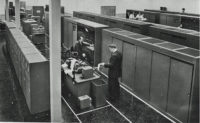The summer of 1963—remembered mostly for the March on Washington—was marked in the construction industry by the arrival of affirmative action. I don't believe I had ever heard the term before, but its entry into our lives was truly dramatic and, a half century later, worth recalling now. In New York City, starting in mid-June
and lasting for a full five months, work was halted on the $25-million annex being built for Harlem Hospital. Pickets, alleging discrimination against blacks and Puerto Ricans in the construction trades, introduced a chant that was taken up by members of a gathering crowd: "If we don't work, nobody works!" When scuffles broke out involving the police and increased violence was threatened, a stop order arrived from City Hall. In November, Mayor Robert Wagner (D) finally permitted activity to resume at the site, saying he had received assurance from the contractor that "a very substantial number of minority-group members" would be hired.
 |
| FLORMAN |
This phenomenon might have been predicted since, nationwide, the civil rights movement was approaching a dramatic climax: the March on Washington that summer of 1963, followed by the Civil Rights Act of 1964 and the Voting Rights Act of 1965. At the same time, it was becoming clear that the battle against discrimination, important as it might have been, did not provide for equal opportunities in employment. The pickets at construction sites were not complaining about prejudice; they were marching for jobs. Actually, in early 1961, President Kennedy had issued an order that projects financed with federal funds "take affirmative action" to ensure that hiring and employment practices were free of racial bias. But no one had any clear idea of how.
A 50-Year Story
The story of affirmative action— challenged by a backlash against "reverse discrimination"—has now been playing itself out for 50 years. Philosophers, jurists, politicians and ordinary concerned citizens, have had much to consider, discuss and debate.
But in my small world of construction, when one of those yellow school buses rolled up to a building site and a group of men piled out demanding jobs, the niceties of constitutional law were not on anybody's mind. Surprise, panic and resentment followed each other in quick succession. Yet, while angry words were often exchanged, the record shows that, in most cases, confrontation was followed by negotiation. Business decisions had to be made. A lengthy delay could spell ruin for the builder as well as failure for those seeking employment. Good sense often called for the making of a deal.
Newspaper stories featured physical violence, and, indeed, there were some fearsome battles, even fights between competing black and Latino groups. Occasionally, extortionists, who were in cahoots with corrupt coalition leaders, sought not jobs, but protection money. A number of these bad guys were arrested, tried and convicted. All the grim stories deserve to be told. But the subplot, too often overlooked in blaring headlines, also deserves to be told.
During the 50 years since the stoppage at Harlem Hospital, thousands of fabulous buildings have been erected and many thousands of minority workers have found their rightful place among the construction trades. No one is totally satisfied; everyone has sad and angry stories to tell. But that is my point. One could say that the construction industry has set an example for the nation. Compromise is often the fuel of progress.
Sam Florman is chairman of Kreisler Borg Florman General Construction Co. and the author of seven books, most recently, "Good Guys, Wiseguys and Putting Up Buildings: A Life in Construction." He can be contacted at scf97@aol.com.


Post a comment to this article
Report Abusive Comment